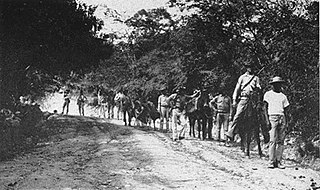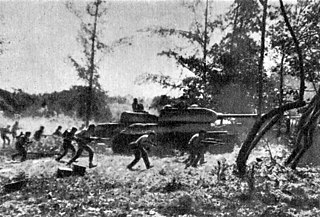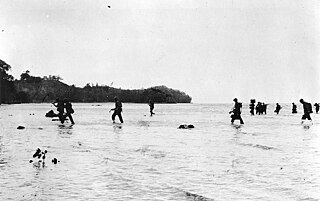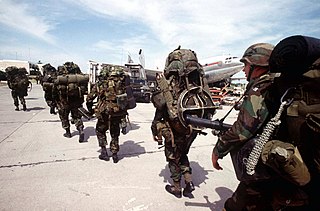 W
WThe United States invasion of Afghanistan occurred after the September 11 attacks in late 2001 and was supported by close US allies. The conflict is also known as the US war in Afghanistan. Its public aims were to dismantle al-Qaeda and deny it a safe base of operations in Afghanistan by removing the Taliban from power. The United Kingdom was a key ally of the United States, offering support for military action from the start of preparations for the invasion. It followed the Afghan Civil War's 1996–2001 phase between the Taliban and the Northern Alliance groups, although the Taliban controlled 90% of the country by 2001. The US invasion of Afghanistan became the first phase of the War in Afghanistan (2001–present).
 W
WThe Allied advance from Paris to the Rhine, also known as the Siegfried Line campaign, was a phase in the Western European campaign of World War II.
 W
WThe Allied invasion of Italy was the Allied amphibious landing on mainland Italy that took place on 3 September 1943 during the early stages of the Italian Campaign of World War II. The operation was undertaken by General Sir Harold Alexander's 15th Army Group and followed the successful invasion of Sicily. The main invasion force landed around Salerno on 9 September on the western coast in Operation Avalanche, while two supporting operations took place in Calabria and Taranto.
 W
WThe American Expeditionary Force, North Russia was a contingent of about 5,000 United States Army troops that landed in Arkhangelsk, Russia as part of the Allied intervention in the Russian Civil War. It fought the Red Army in the surrounding region during the period of September 1918 through to July 1919.
 W
WThe American Expeditionary Force, Siberia was a formation of the United States Army involved in the Russian Civil War in Vladivostok, Russia, after the October Revolution, from 1918 to 1920. The force was part of the larger Allied North Russia Intervention. As a result of this expedition, early relations between the United States and the Soviet Union were poor.
 W
WThe American-led intervention in the Syrian Civil War refers to the United States-led support of the Syrian rebels and the Syrian Democratic Forces (SDF) during the course of the Syrian Civil War, including Combined Joint Task Force - Operation Inherent Resolve (CJTF-OIR), the active military operation led by the United States, and involving the militaries of the United Kingdom, France, Jordan, Turkey, Canada, Australia, and others against the Islamic State of Iraq and the Levant (ISIL) and al-Nusra Front since 2014. Since early 2017, the U.S. and its partners have also targeted the Syrian government and its allies via airstrikes and aircraft shoot-downs.
 W
WThe Banana Wars were occupations, police actions, and interventions on the part of the United States in Central America and the Caribbean between the end of the Spanish–American War in 1898 and the inception of the Good Neighbor Policy in 1934. These military interventions were most often carried out by the United States Marine Corps, which developed a manual, The Strategy and Tactics of Small Wars (1921) based on its experiences. On occasion, the Navy provided gunfire support and Army troops were also used.
 W
WThe Bay of Pigs invasion was a failed landing operation on the southwestern coast of Cuba in 1961 by Cuban exiles who opposed Fidel Castro's Cuban Revolution. Covertly financed and directed by the U.S. government, the operation took place at the height of the Cold War, and its failure led to major shifts in international relations between Cuba, the United States, and the Soviet Union.
 W
WThe Cambodian campaign was a brief series of military operations conducted in eastern Cambodia, which was a neutral country, in 1970 by South Vietnam and the United States as an extension of the Vietnam War and the Cambodian Civil War. Thirteen major operations were conducted by the Army of the Republic of Vietnam (ARVN) between 29 April and 22 July and by U.S. forces between 1 May and 30 June.
 W
WThe Dominican Civil War took place between April 24, 1965, and September 3, 1965, in Santo Domingo, Dominican Republic. It started when civilian and military supporters of former President Juan Bosch overthrew acting President Donald Reid Cabral. The coup prompted General Elías Wessin y Wessin to organize elements of the military loyal to President Reid ("loyalists"), initiating an armed campaign against the so-called constitutionalist rebels. Allegations of foreign support for the rebels led to a United States intervention in the conflict, which later transformed into an Organization of American States occupation of the country. Elections were held in 1966, in the aftermath of which Joaquín Balaguer was elected into the presidential seat. Later in the same year international troops departed from the country.
 W
WOperation Dragoon was the code name for the landing operation of the Allied invasion of Provence on 15 August 1944. The operation was initially planned to be executed in conjunction with Operation Overlord, the Allied landing in Normandy, but the lack of available resources led to a cancellation of the second landing. By July 1944 the landing was reconsidered, as the clogged-up ports in Normandy did not have the capacity to adequately supply the Allied forces. Concurrently, the French High Command pushed for a revival of the operation that would include large numbers of French troops. As a result, the operation was finally approved in July to be executed in August.
 W
WThe invasion of Elba, codenamed Operation Brassard, was part of the Italian campaign during the Second World War. The invasion was carried out by Free French Forces supported by British and American ships and aircraft.
 W
WThe Géo Gras Group was a French resistance movement that played a decisive role during Operation Torch, the British-American invasion of French North Africa during WWII.
 W
WThe Battle of Guantánamo Bay was fought from June 6 to June 10 in 1898, during the Spanish–American War, when American and Cuban forces seized the strategically and commercially important harbor of Guantánamo Bay, Cuba. Capturing the bay from the Spanish forces was instrumental in the following Battle of Santiago de Cuba and the subsequent invasion of Puerto Rico. Although overshadowed by the land and sea battles at Santiago, the establishment of the United States naval base at Guantánamo Bay and the rout of defending Spanish troops by American and Cuban forces was important in the final Spanish defeat.
 W
WThe 2003 invasion of Iraq was the first stage of the Iraq War. The invasion phase began on 19 March 2003 (air) and 20 March 2003 (ground) and lasted just over one month, including 26 days of major combat operations, in which a combined force of troops from the United States, the United Kingdom, Australia and Poland invaded Iraq. This early stage of the war formally ended on 1 May 2003 when U.S. President George W. Bush declared the "end of major combat operations", after which the Coalition Provisional Authority (CPA) was established as the first of several successive transitional governments leading up to the first Iraqi parliamentary election in January 2005. U.S. military forces later remained in Iraq until the withdrawal in 2011.
 W
WThe Battle of Iwo Jima was a major battle in which the United States Marine Corps and Navy landed on and eventually captured the island of Iwo Jima from the Imperial Japanese Army (IJA) during World War II. The American invasion, designated Operation Detachment, had the purpose of capturing the island with its two airfields: South Field and Central Field The strategic objectives were twofold: the first was to provide for B-29s unable to make it back to Tinian. The second was to provide air fields for shorter ranged fighters to be staged to extend fighter coverage to the bombers. The island could also serve as a staging point for attacks on Japanese main islands. The five-week battle saw some of the fiercest and bloodiest fighting of the Pacific War.
 W
WThe Landing at Aitape was a battle of the Western New Guinea campaign of World War II. American and Allied forces undertook an amphibious landing on 22 April 1944 at Aitape on northern coast of Papua New Guinea. The amphibious landing was undertaken simultaneously with the landings at Humboldt and Tanahmerah Bays to secure Hollandia to isolate the Japanese 18th Army at Wewak. Operations in the area to consolidate the landing continued until 4 May, although US and Japanese forces fought further actions in western New Guinea following a Japanese counter-offensive that lasted until early August 1944. Aitape was subsequently developed into an Allied base of operations and was used by Australian forces throughout late 1944 and into 1945 during the Aitape–Wewak campaign.
 W
WThe Invasion of Lingayen Gulf, 6–9 January 1945, was an Allied amphibious operation in the Philippines during World War II. In the early morning of 6 January 1945, a large Allied force commanded by Admiral Jesse B. Oldendorf began approaching the shores of Lingayen. U.S. Navy and Royal Australian Navy warships began bombarding suspected Japanese positions along the coast of Lingayen from their position in Lingayen Gulf for three days. On 9 January, the U.S. 6th Army landed on a 20 mi (32 km) beachhead between the towns of Lingayen and San Fabian.
 W
WThe Normandy landings were the landing operations and associated airborne operations on Tuesday, 6 June 1944 of the Allied invasion of Normandy in Operation Overlord during World War II. Codenamed Operation Neptune and often referred to as D-Day, it was the largest seaborne invasion in history. The operation began the liberation of German-occupied France and laid the foundations of the Allied victory on the Western Front.
 W
WThe Battle of Okinawa , codenamed Operation Iceberg, was a major battle of the Pacific War fought on the island of Okinawa by United States Marine and Army forces against the Imperial Japanese Army. The initial invasion of Okinawa on April 1, 1945, was the largest amphibious assault in the Pacific Theater of World War II. The Kerama Islands surrounding Okinawa were preemtively captured on March 26th, (L-6) by the 77th Infantry Division. The 98-day battle lasted from March 26th until July 2nd, 1945. After a long campaign of island hopping, the Allies were planning to use Kadena Air Base on the large island of Okinawa as a base for Operation Downfall, the planned invasion of the Japanese home islands, 340 mi (550 km) away.
 W
WThe American invasion of island of Okinawa, codenamed Operation Iceberg, took place 1 April 1945. The Japanese military was determined to inflate a casualty rate so high that the U.S. government would choose not to invade the Japanese home islands. To this end, the southern portion of the island had been covered with the most extensive system of fortifications and fields of fire yet encountered in the Pacific War.
 W
WOperation Overlord was the codename for the Battle of Normandy, the Allied operation that launched the successful invasion of German-occupied Western Europe during World War II. The operation was launched on 6 June 1944 with the Normandy landings. A 1,200-plane airborne assault preceded an amphibious assault involving more than 5,000 vessels. Nearly 160,000 troops crossed the English Channel on 6 June, and more than two million Allied troops were in France by the end of August.
 W
WThe Philippine–American War, also referred to as the Filipino–American War, the Philippine War, the Philippine Insurrection or the Tagalog Insurgency, was an armed conflict between the First Philippine Republic and the United States that lasted from February 4, 1899 to July 2, 1902. While Filipino nationalists viewed the conflict as a continuation of the struggle for independence that began in 1896 with the Philippine Revolution, the U.S. government regarded it as an insurrection. The conflict arose when the First Philippine Republic objected to the terms of the Treaty of Paris under which the United States took possession of the Philippines from Spain, ending the Spanish–American War.
 W
WThe Raid at Renacer Prison was an attack on the El Renacer prison in Gamboa, Panama, by units of the 82nd Airborne Division of the US Army on 20 December 1989, during the United States invasion of Panama. During the raid the U.S. military freed the sixty-four prisoners held in the detention facility and killed 5 soldiers of the Panama Defense Forces.
 W
WScarlett Martínez International Airport, also known as Río Hato Airport, is an international airport serving Río Hato, a town in the Coclé Province of Panama. The airport is 3 kilometres (2 mi) east of Río Hato.
 W
WThe American-led intervention in the Syrian Civil War refers to the United States-led support of Syrian opposition and the Federation of Northern Syria during the course of the Syrian Civil War and active military involvement led by the United States and its allies — the militaries of the United Kingdom, France, Jordan, Turkey, Canada, Australia and more — against the Islamic State of Iraq and the Levant (ISIL) and al-Nusra Front since 2014. Since early 2017, the U.S. and other Coalition partners have also targeted the Syrian government and its allies via airstrikes and aircraft shoot-downs.
 W
WOperation Torch was an Allied invasion of French North Africa during the Second World War. The French colonies in the area were dominated by the French, formally aligned with Germany but of mixed loyalties. Reports indicated that they might support the Allies. American General Dwight D. Eisenhower, supreme commander of the Allied forces in the European Theater, planned a three-pronged attack on Casablanca (Western), Oran (Center) and Algiers (Eastern), then a rapid move on Tunis.
 W
WThe Battle of Tulagi and Gavutu–Tanambogo was a land battle of the Pacific campaign of World War II, between the forces of the Imperial Japanese Navy and Allied ground forces. It took place from 7–9 August 1942 on the Solomon Islands, during the initial Allied landings in the Guadalcanal campaign.
 W
WThe United States invasion of Grenada began at dawn on 25 October 1983. The U.S. and a coalition of six Caribbean nations invaded the island nation of Grenada, 100 miles (160 km) north of Venezuela. Codenamed Operation Urgent Fury by the U.S. military, it resulted in military occupation within a few days. It was triggered by the strife within the People's Revolutionary Government which resulted in the house arrest and execution of the previous leader and second Prime Minister of Grenada Maurice Bishop, and the establishment of the Revolutionary Military Council with Hudson Austin as Chairman. The invasion resulted in the appointment of an interim government, followed by democratic elections in 1984. The country has remained a democratic nation since then.
 W
WThe United States Invasion of Panama, codenamed Operation Just Cause, lasted over a month between mid-December 1989 and late January 1990. It occurred during the administration of President George H. W. Bush and ten years after the Torrijos–Carter Treaties were ratified to transfer control of the Panama Canal from the U.S. to Panama by 1 January 2000. During the invasion, de facto Panamanian leader, general and dictator Manuel Noriega, who for a long time worked with the Central Intelligence Agency, was deposed citing racketeering and drug trafficking. Following the operation, the Panama Defense Forces were dissolved and President-elect Guillermo Endara was sworn into office.
 W
WOperation Uphold Democracy was a military intervention designed to remove the military regime installed by the 1991 Haitian coup d'état that overthrew the elected President Jean-Bertrand Aristide. The operation was effectively authorized by the 31 July 1994 United Nations Security Council Resolution 940.
 W
WThe War in Afghanistan stems from the United States invasion of Afghanistan on 7 October 2001, when the United States of America and its allies successfully drove the Taliban from power in order to deny Al-Qaeda a safe base of operations in Afghanistan. Since the initial objectives were completed, a coalition of over 40 countries formed a security mission in the country called International Security Assistance Force, of which certain members were involved in military combat allied with Afghanistan's government. The war has afterwards mostly consisted of Taliban insurgents fighting against the Afghan Armed Forces and allied forces; the majority of ISAF/RS soldiers and personnel are American. The war is code named by the US as Operation Enduring Freedom (2001–14) and Operation Freedom's Sentinel (2015–present); it is the longest war in US history.